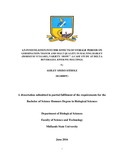Please use this identifier to cite or link to this item:
https://cris.library.msu.ac.zw//handle/11408/2565| Title: | An investigation into the effects of storage periods on germination vigour and malt quality in malting barley (hordeum vulgare), variety “hope” :a case study at Delta beverages, Kwekwe maltings | Authors: | Sithole, Ashley Simiso | Keywords: | Malts High enzymatic |
Issue Date: | Jun-2016 | Publisher: | Midlands State University | Abstract: | Malts with high extract values, high enzymatic activities and good modification are fundamental to increase the brewing yield and efficiency. To produce malt that meets these requirements, the barley employed must have minimal post-harvest dormancy and be able to germinate rapidly and uniformly. The aims of this study were to assess the changes in seed germination vigour trends and the general storage stability of a Zimbabwean two-row malting barley variety “Hope” as the post-harvest storage time increased. Five samples of this commercially grown variety were obtained and stored under room temperature conditions. The samples had their germination capacity and energy determined using SAB Miller standards for malting barley analysis (controlled germination in an incubator at 180C – 210C for 72 hours). In addition other quality parameters (moisture content, water sensitivity, diastatic power, total extracts, free amino nitrogen and friability) necessary to assess the storage stability were analyzed using the same analytical standards as for germination tests for each sample. Results showed that “Hope” is better malted after a storage time of 2 years meaning that, the variety’s germination vigour improves with time. However, at storage periods of more than 2 years, undesirable quality trends were observed and this could be because most of the grains are presumed dead. Malting of grains just after harvest also produced undesirable results probably because the grains were still dormant as dormancy breaks after 3 months of harvest. Dormancy is a common characteristic of seeds that retards rapid and uniform germination and thus it has the potential to affect malt quality adversely. Parameters measured before malting are moisture content, germination capacity, germination energy and water sensitivity. The results showed an increase with decrease into storage years, that is from 2011-2015. An exception was observed in water sensitivity as the results showed a decrease as years into storage decreased. Results after malting showed general increases as years into storage decreased, that is for, DP, FAN and extracts. However, for filtration speed, friability, PUGS, WUGS and TSN a decrease was observed with decreases in storage years. From the results obtained, it can also be concluded that “Hope” is more stable in storage of not more than two years. Thus after considering germination performance and general malt quality after storage it was concluded that “Hope” is a good malting barley variety. Since all malt quality parameters measured in this study significantly influence brewery efficiency, these findings have a significant commercial impact. | URI: | http://hdl.handle.net/11408/2565 |
| Appears in Collections: | Bsc Biological Sciences Honours Degree |
Files in This Item:
| File | Description | Size | Format | |
|---|---|---|---|---|
| FINAL PROJECT.pdf | Full Text | 1.71 MB | Adobe PDF |  View/Open |
Page view(s)
108
checked on Apr 4, 2025
Download(s)
126
checked on Apr 4, 2025
Google ScholarTM
Check
Items in MSUIR are protected by copyright, with all rights reserved, unless otherwise indicated.



